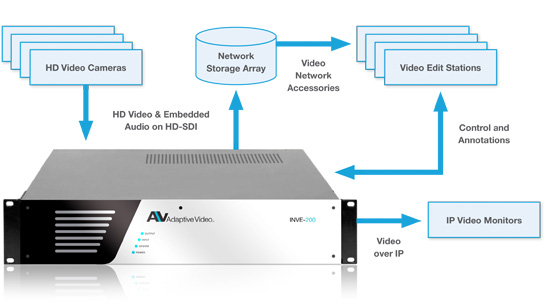NVE-2000 Overview
Ingest Encoding Technology
The NVE-2000 allows production teams to create higher quality programs in less time by integrating the work of camera operators, content annotators and video editors. The NVE-2000 streamlines complex production workflows by receiving multiple video camera feeds, preparing the video for editing and storing the processed video in a network-attached storage array, all in real time.
Overview

• Compute-intensive tasks, such as reformatting and video encoding are off-loaded from the editing workstations
• In-line review and tag capabilities allow annotation of high value content, allowing editors to spend less time searching through clips for specific content
• Secure transfer of video clips to network storage insures that important clips never get lost or dropped, even during times of network congestion, momentary equipment failures or operator error
Operation
The NVE-2000 integrates a high performance video encoder, flexible video format converter with video tagging and storage management buffer to streamline real time production work flows.
Applications
• Multi-Camera video productions
• Productions with rapid editing requirements
• Productions extracting small amounts of program content from large amounts of camera video
Signal Inputs & Outputs
• 2 HD-SDI Inputs
• 1 Gigabit Ethernet Control Port
• 2 Gigabit Ethernet IP Video Outputs
• 1 DVI Local Video Monitor Port
Simple Web Based User Controls
Embedded web pages provide the user with a simple means of controlling all major functions of the NVE-200 in-line video encoder.
Front Panel Displays
The richness of control and status information presented through the NVE-2000 web pages contrasts with the minimalist front panel LED’s, which indicate the status of the NVE-2000 system, power, input and output signals.
Production Automation Ready
Fault conditions such as signal loss may be reported through a variety of available methods, including discrete contact closures, IP messages and SNMP traps.









